“The goal of farming,” wrote Masanobu Fukuoka, farmer and author of One Straw Revolution, “is not the growing of crops, but the cultivation and perfection of human beings”.
The delicate words of this Japanese maestro echo all over the Catskill Mountains as young people, city-bred and country-born, return to farming in droves. Agricultural courses spring up like new shoots across the Northeastern states to respond to demand. Furthermore, there’s a flurry of articles regularly in the media about diverse people quitting New York City. Young, old, wealthy and those tired of the city’s rising cost of living are all looking to make upstate their home. Homesteading is an art in itself and the Catskills are bustling with creative activity. Small-scale farming, the kind that covers the property’s operating costs, doesn’t have to be an enormous amount of work and new busy upstaters with enough capital can now hire farmers and farmer’s apprentices to run their farms while they continue their existing businesses. City transplants who have made the leap quickly find that there’s an invigorating honesty in land cultivation that is rarely found in city life.
Novice homesteaders looking for an exquisitely picturesque organic farm on which to model their fledgling operation should look no further than Two Stones Farm in Halcott, New York.
Owner Alan White has 35 acres, 15 of which he uses for farming. The bulk of his operation is animal husbandry: he keeps goats, alpacas, guinea fowl, chickens and two guard dogs protect the lot day and night. A graduate of Cornell University, White holds a degree in agriculture and has lived in the Catskills for 33 years. This is his dream job and he appears to have it down to an exact science because he’s “been tinkering with it for 30 years”. How many of us use our degrees? White bought his property for “the lie of the land” and set about rebuilding the existing house. When he and his wife were looking for property his wife’s only requirements were “a view and a stream”.
“Around here there are many more than two stones for every dirt,” he says, but the name Two Stones stuck. “For farming, 35 acres is not large, but for homesteading it’s plenty”.
The soil in the upper elevations of the mountains here is acidic as well as stony and crops that like wet, cool weather do well here. “A lot of the pasture here was very brushy, but if you treat it like an ecosystem and think about how to get it to move… you can do it, but you just need to have some patience. I could turn this very quickly back into more productive land by bringing in [chemical] fertilizers, spreaders and sprayers and plough, but I just don’t want to do that. I’m an environmental [ly-minded person] so I don’t want to have any kind of density that causes problems.”
White works hard to try to make everything fit together as an ecosystem rather than forcing it with chemicals. He started the farm in earnest 11 years ago and has created a riparian buffer along both banks of the stream. A riparian buffer is a natural barrier that protects a waterway from agricultural activity. If you stop mowing the grass either side of a stream for an extended period, trees, bracken and bushes will spring up and act as a natural filter. As a result of such careful cultivation on Two Stones, a beautiful willow tree has grown of its own accord. At some point in the future, White will not be able to see his far pasture (behind the shed) because the riparian buffer either side of the stream will grow up into a forest and will be its own separate ecosystem protecting the waterway. He doesn’t use the land adjacent to the riparian buffer as added insurance to keep the integrity of the waterway running through his property.
White stresses the importance of making things easy for yourself from the outset; find out what grows well on your land and grow that. He grows blueberries, potatoes, asparagus, raspberries, broccoli, and beans and separates the perennials from the annuals in two fenced-off beds. Crop rotation is an organic way to deter pests, but some annual vegetables make the soil too acidic for other vegetables to grow, so you have to rotate those in their own area.
When White rebuilt the original structure on his land, he was mindful of its size. He purposely did not build a big house so that it would not be too expensive to run. He has a solar array that provides electricity year-round for his house and is also big enough to power the electric car that his wife drives to work and back every day which is an hour’s round-trip. Half of the woodshed (pictured below) is used to heat the home in the winter.
His array is tied to the national grid as he is not “convinced battery systems are the way to go. You should size your solar array to be about the size that you need to get sufficient energy for your needs because if you have any extra electricity, you won’t make a profit from selling it to the utility company. They will pay you 4 cents per unit and sell it back to you for 14 cents and there’s no profit in subsidizing the utility company.” The array cost $26,000 “soup to nuts: you get $10,000 raked off with rebates, then federal and state income tax credits, so I’m out of pocket $7,000. Considering that we have one car that never has to go to the gas station, that’s pretty good pay back”.
Master of the gentle understatement, White says: “so from the standpoint of living in a way that you think is closer to being [environmentally] correct, we are making progress”. By 3pm on the day of our interview, his solar array had generated 23 kilowatt hours and on a cloudy day, it’s possible for White to make 30% of his capacity. The perception that solar power is not viable in the Catskills is a fallacy according to White. In some winter months, like March his array has generated 35-40 kilowatt hours in one day.
The major enterprise of the whole operation is a carefully reared breed of meat goats that will eventually become native to the mountains, an eternal gift to the Catskills from the Maine native. “I’ve taken seven different breeds of goats and am recombining those breeds to come up with a composite that is suitable for the Catskills. Goats tend to be from arid climates, so they don’t have resistance to wet feet or parasites, but there are some breeds that do.”
One of his goats “is at least half Kiko from New Zealand, which is a breed that shows some of the best resistance to parasites and strongest feet, but not the best breed for meat. My breed, when I’m finished – and I’m about 10 years out – will be a composite, dual-purpose breed that will do for both dairy and meat. For a farm like Two Stones that is steep and rocky, goats are the ideal animals. Any kind of cow will be punching up the soil in the spring because it’s wet. Goats really like the browse (bracken and low lying bushes) that is prevalent here. ”
If you’re trying to clean up land for farm use and you’d like to do it without chemicals, you can do it with goats. In fact, there’s actually good business in renting out goats for brush clearance. White is employing his goats to clear a wooded area that he is harvesting for firewood, leaving only the oak trees. His goats will eat the leaves off the felled trees that he will later chop into firewood. This will leave a canopy of oaks that will drop acorns to feed the goats. The kids literally eat off the fat of the land.
The farm is on its fifteenth generation of goat and they kid every eight to ten months. There is room for 20 breeding females and every year those females have 40 kids, so White must decide which of the 60 he would like to keep. He wants to maintain a density that he’s comfortable with so he sells breeding stock all over the country. There’s a lucrative trade for people wanting to start a small enterprise and you don’t want goats from South America. You want goats that thrive in the Catskills. Two years ago, White brought in a feral breed of goats from New Zealand called Arapawa. These feral goats had been left to their own devices on the island of Arapawa for 250 years, but after increasing in number to sufficiently decimate the island’s ecosystem, their fate was sealed and the government decided to destroy them. Before that happened a rare breed conservancy decided this breed was unique, so they exported 40 to various conservancies including one in Rhode Island. White obtained one and bred them into his herd. “My theory was that a breed of goats that had no human intervention for 250 years had to be pretty hardy. Natural selection is the best kind of selection. A bunch of my goats are 50% Arapawa.”
Ears are the challenges here, because when it gets 10 below zero the goats’ ears get frostbitten, so he’s breeding goats with shorter ears.
The alpacas are giving Two Stones Farm another species to graze and all their wool is used. Mrs White spins, weaves and knits and their five alpacas produce five pounds of wool each per year. Alpaca was wool designed for royalty in South America so it’s very soft and fine. In the winter, the alpacas’ coats are so warm that the snow does not melt off their back and they walk around carrying feet of snowdrift. The alpacas get shorn in May, when the temperature is best for them. They get really uncomfortable when it gets warm and they have their full fleece on, but it must be timed correctly. One aberrantly low-temperature spring evening will have the bare, skinny alpacas shivering.
Alpacas will create a regular place to defecate every day, which seems kind and considerate, but actually gives White more shoveling to do than if they had spread it about on their own. Talking of waste, there’s a steaming manure pile in the middle of the grazing pasture that’s about four by four by five feet and needs a regular stir. He turns the pile at least once a week to aerate it and will end up with about three piles that size in a year that replaces any chemical fertilizer he would ordinarily need for a non-organic enterprise.
The barn is also carefully cultivated place that is run as a “bedded pack”. The goats and alpacas are fed hay and then as they eat the hay, they produce waste that gets spread around, so it’s always dry, but it builds up. This causes residual heat in the barn that is always about seven to ten degrees warmer than outside. The Two Stone animal is required to adapt to this temperature or it quickly gets sold.
“The only time I get into trouble is when I kid in January or February, because then it’s really tough. Or February. They would like to give birth in January, but that doesn’t work for me, or this climate so, because there’s a five-month gestation period for goats, I separate out the buck in August and September. ”
All the animals have their diet supplemented with grain, but not too much.
White has two guard dogs for his animals: a Great Pyrenees and an Anatolian Shepherd who see off coyotes, the main predator. He also has a barn full of grain so it’s in his best interests to keep predators away. Bears also stay away from the farm because they smell the dogs. Completely independent, the guard dogs stay with the animals day and night, feed themselves and even fish in the stream.
Two Stones has a few brace of guinea fowl taking care of the tick problem, three chickens producing one egg each a day and a rooster.
“People assume farming is undoable,” says White, “but it really isn’t. I can run this entire farm with 20 minutes in the morning, 30 minutes in the evening and one weekend day by deliberately avoiding all the aspects that make this a full-time job. For example, I do some milking, but only as I need to. When I don’t need any more milk I will stop. The milk from that particular goat will dry up and if I ever need more milk, I will choose another goat.”
White sells goat’s milk products like soap, cheese and milk too.
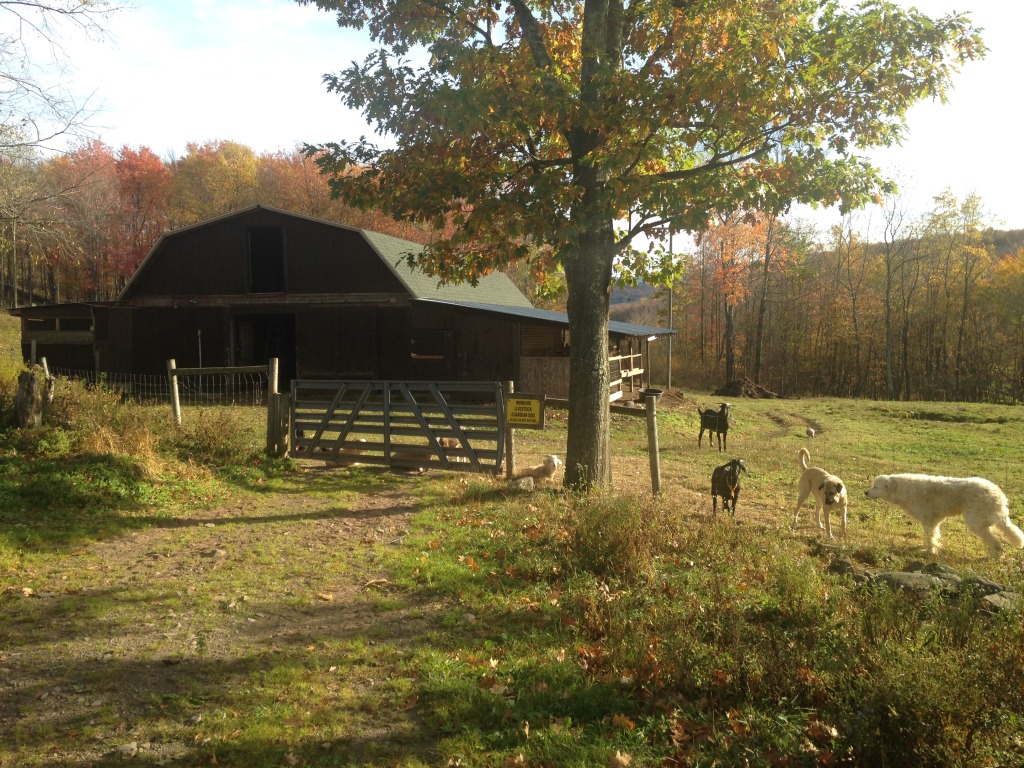
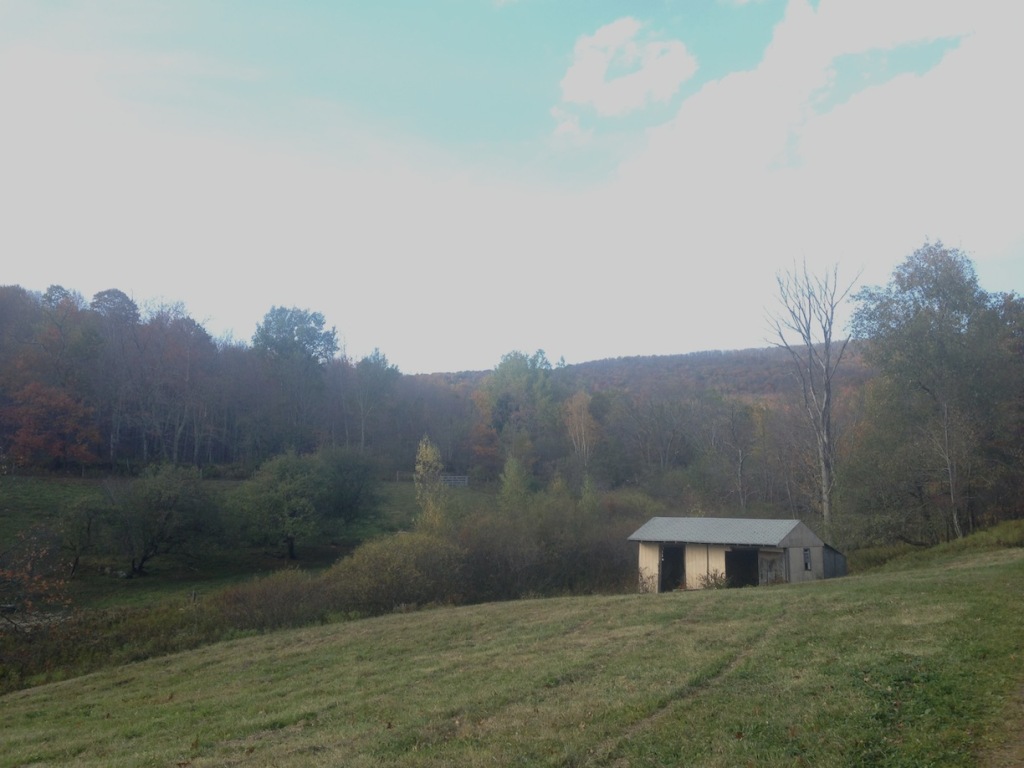
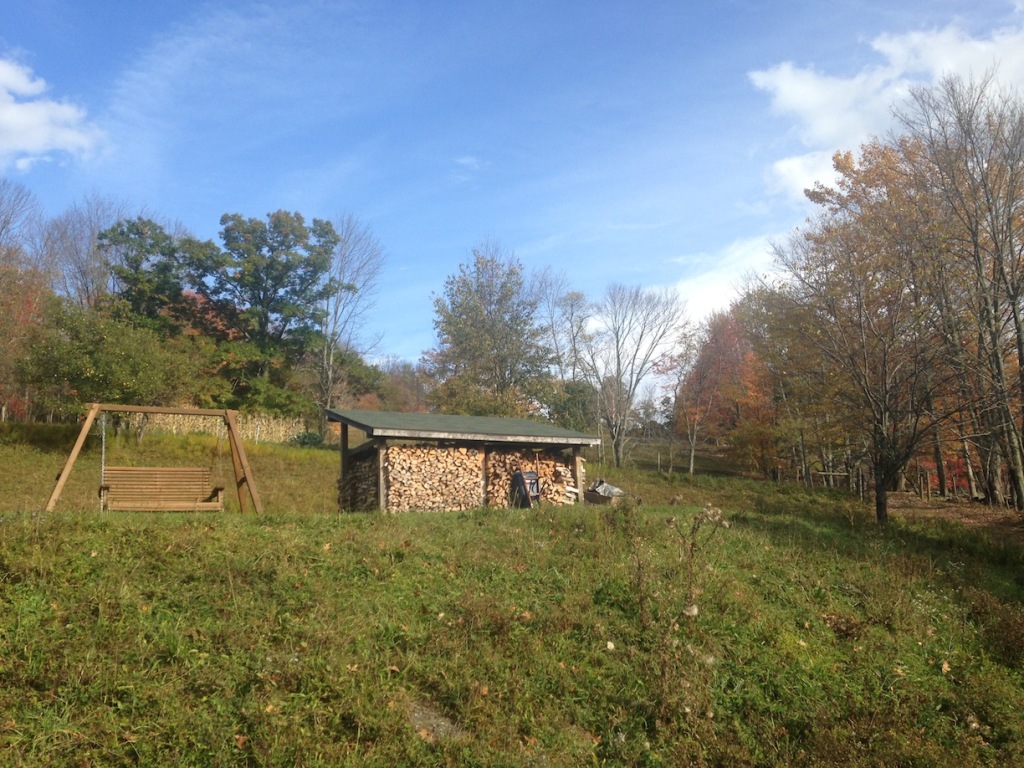
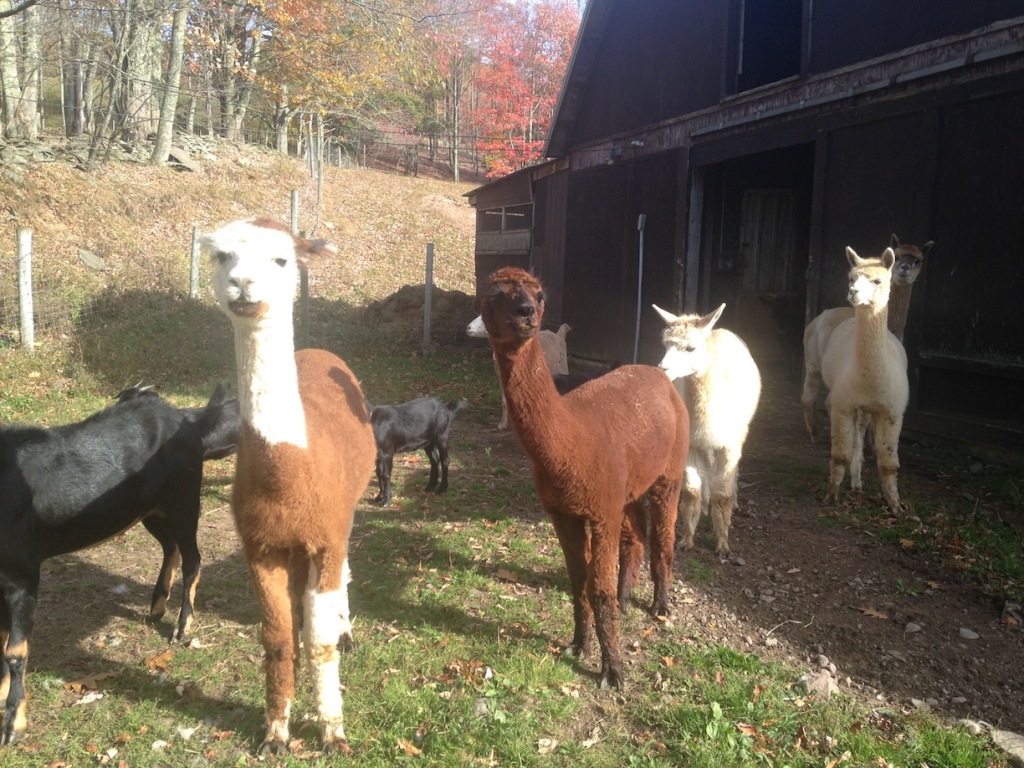
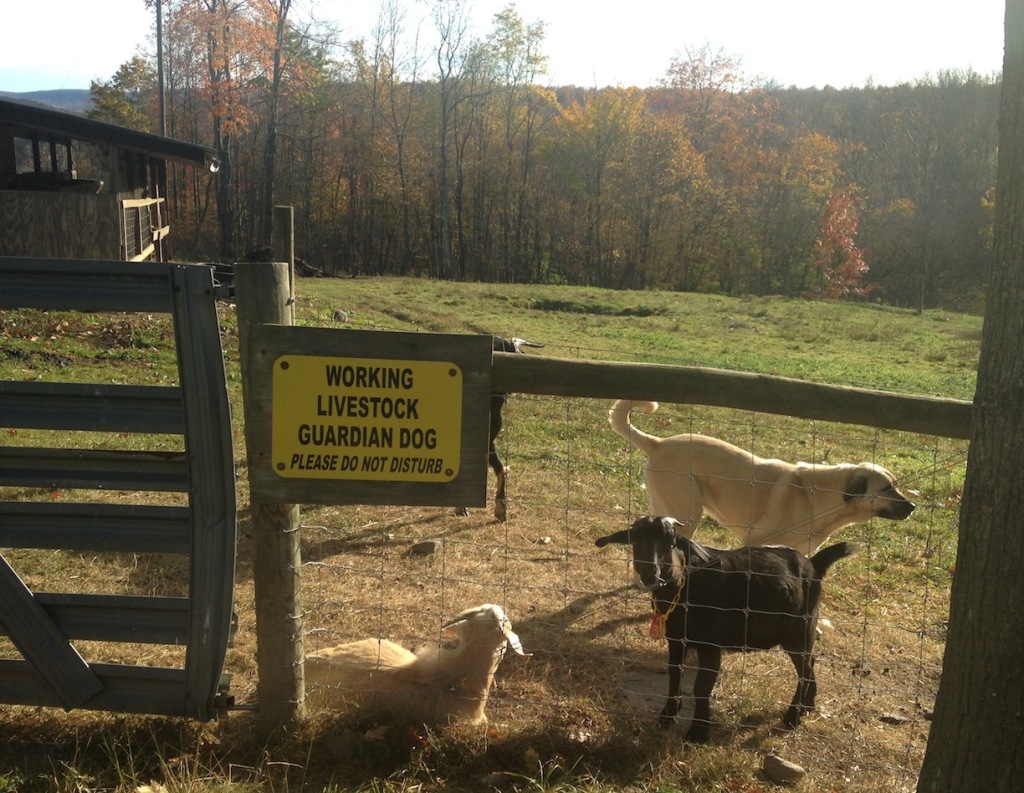
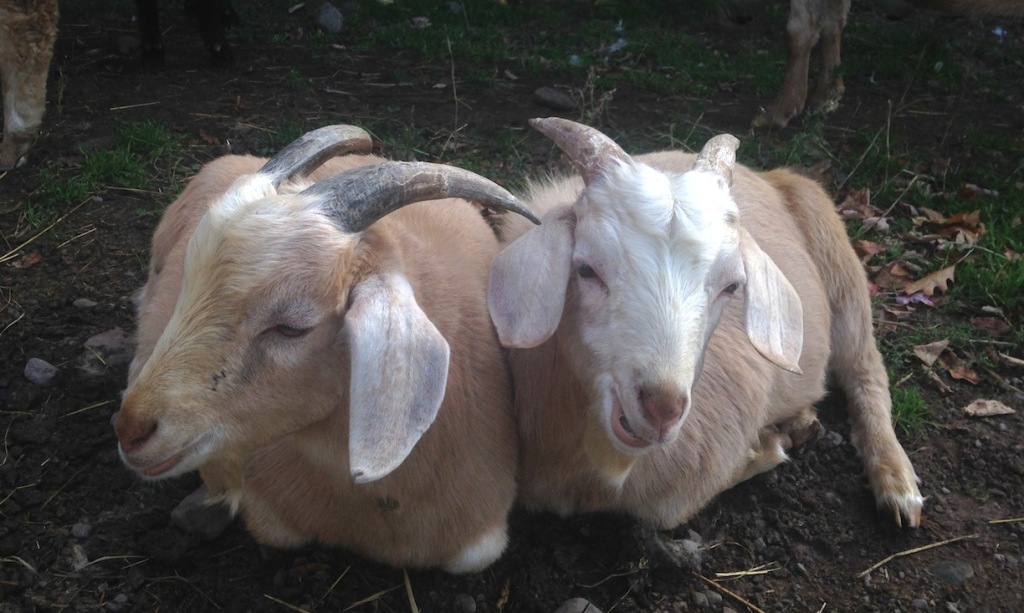
Absolutely lovely!
Pingback: Local, Antique & Vintage Holiday Gift Guide 2014 | UPSTATE DISPATCH
Pingback: Catskills Cocktail: Vodka Soda with Rhubarb Syrup | UPSTATE DISPATCH
Pingback: Holiday Gift Guide: Catskills Stocking Stuffers | UPSTATE DISPATCH
Pingback: Bee Wild & Free | UPSTATE DISPATCH
Pingback: The Arts Inn, Fleischmanns, NY | UPSTATE DISPATCH